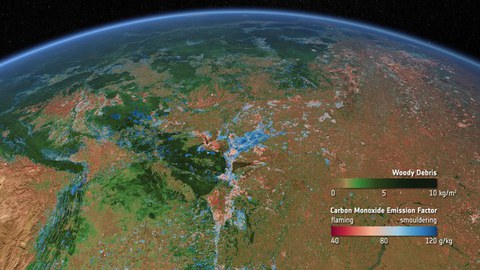Jan 30, 2025
New publication on forest fire emissions in Nature Geoscience

Forest fires in the southern Amazon region in 2020. Brown to green colors indicate the amount of dead wood, which is the main factor determining emissions from fires. Flaming forest fires (red colors) release less carbon monoxide than smoldering forest fires (blue colors).
Satellite observations show the impact of forest fires on the carbon cycle
A groundbreaking study has found that emissions from vegetation fires in the Amazon and Cerrado ecosystems are mainly caused by the smoldering combustion of wood residues. This finding, now published in the journal Nature Geoscience, underlines the crucial role of the nature of the fuel for the emissions released during combustion and their impact on the global carbon cycle, air quality and biodiversity.
The study presents the key findings of the international Sense4Fire project(https://sense4fire.eu/) carried out by TUD Dresden University of Technology (TUD) in collaboration with the Royal Netherlands Meteorological Institute (KNMI), BeZero Ltd. and several international partners with funding from the European Space Agency (ESA).
Original publication in Nature Geoscience:
Forkel, M., Wessollek, C., Huijnen, V., Andela, N., de Laat, J., Kinalczyk, D., Marrs, C., van Wees, D., Bastos, A., Ciais, P., Fawcett, D., Kaiser, J.W., Klauberg, C., Kutchartt, E., Leite, R.V., Li, W., Silva, C.A., Sitch, S., Goncalves De Souza, J., Zaehle, S., Plummer, S., 2025. Burning of woody debris dominates fire emissions in the Amazon and Cerrado. Nature Geoscience https://doi.org/10.1038/s41561-024-01637-5
Further information in the TU Dresden press release